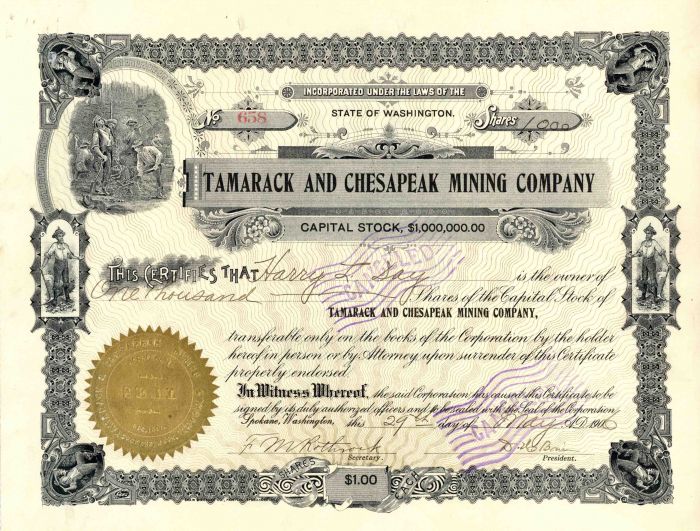Tamarack and Chesapeak Mining Co. - Mining Stock Certificate
Inv# MS1363 Stock
7 vignettes. Interesting title from a rather scarce state. Issued from Spokane, WA. Total of 7 mining related vignettes! Nice gold seal. Rare!!!
The Tamarack & Chesapeak Mining Co. -- no explanation has been found as to why Chesapeak lacks the final "e" -- was incorporated in 1897 to manage a number of claims above Burke Canyon in Shoshone County, Idaho. The major stockholder and manager before 1906 was Daniel Brien, a Wallace, Idaho, physician. The Day brothers, convinced of the value of the Tamarack & Chesapeak holdings, began buying up stock quietly, acquiring proxies and delinquent stock. By 1906 they controlled the majority of shares and were in a position to oust Brien and elect themselves to the board of directors. Harry Day became president and manager. Litigation followed in which Brien claimed ownership, through his Snowy Peak Mining Company, of certain company properties.
By 1913 the Days emerged as the victors but were required to pay compensation for some of the lode claims in question. Daniel Brien subsequently left the area; his last known address according to the local paper was Seoul, Korea. When title to the Tamarack & Chesapeak holdings had been settled, the Days merged this firm with their adjacent Custer Consolidated Mining Company to form the Tamarack & Custer Consolidated Mining Company.
Shoshone County is a county in the U.S. state of Idaho. As of the 2020 census, the population was 13,169. and the largest city is Kellogg. The county was established in 1864, named for the Native American Shoshone tribe.
Shoshone County is commonly referred to as the Silver Valley, due to its century-old mining history. The Silver Valley is famous nationwide for the vast amounts of silver, lead, and zinc mined from it.
Shoshone County was formed under the Territory of Washington on January 9, 1861. Washington Territory legislators established the county in anticipation of the gold rush that occurred after the discovery of gold at Pierce in October, 1860. Their location of the northern boundary at a line drawn due east from the mouth of the Clearwater River, unknowingly placed the emerging mining settlement at Pierce outside of the county's boundaries while residents of the new Mormon settlement at Franklin were unknowingly within the established boundaries. Regardless of the geographic reality, the county seat was at Pierce. Growth at Pierce was so rapid that Shoshone County boasted the largest vote of any county within Washington Territory at the territorial election of July 8, 1861. In less than a year, Shoshone County contained additional settlements at Lewiston, Elk City, Newsome, and Florence. On December 20, 1861, Nez Perce and Idaho counties were created from most of the original territory of Shoshone County. On the following day, Shoshone's boundaries were shifted northward, containing most of present-day Clearwater County and a portion of present-day Shoshone County.
This new boundary alignment left the existing settlement at Pierce and the new settlement of Orofino as the county's only settlements. The county's population dwindled as prospectors abandoned Pierce for gold prospects at Elk City and Florence. Idaho Territory was created in 1863 and the first census of the territory in that year enumerated only 574 residents in Shoshone County. The county boundaries were expanded to include the Silver Valley by the legislative assembly of Idaho Territory when it officially created Shoshone County on February 4, 1864. The expanded territory contained no population at the second census of Idaho Territory in 1864. All of the county's 276 residents were located at Pierce and Orofino.
Until 1904, Shoshone County included present-day Clearwater County to the south. That portion was annexed by Nez Perce County for several years and then was established as a new county in 1911. When the Silver Valley population rose dramatically in the 1880s, the seat was moved to Murray in 1884 (and to Wallace in 1898) to better serve the majority of the county's population. The southern area's population increased with homesteading in the Weippe area in the late 1890s. The vast distance and time required for travel to Wallace from the Clearwater River area prompted the southern portion to move to Nez Perce County.
Hard rock miners in Shoshone County protested wage cuts with a strike in 1892. After several lost their lives in a shooting war provoked by discovery of a company spy, the U.S. army forced an end to the strike. Hostilities erupted once again in 1899 when, in response to the company firing seventeen men for joining the union, the miners dynamited the Bunker Hill & Sullivan mill. Again, lives were lost, and the U.S. Army intervened, requested by Governor Frank Steunenberg, as the Idaho National Guard troops were still stationed in the Philippines following the Spanish–American War. Steunenberg was assassinated outside his residence in Caldwell in 1905, nearly five years after leaving office, and the subsequent trials in Boise in 1907 made national headlines.
Much of the county was burned in the Great Fire of 1910, including part of the town of Wallace.
A stock certificate is issued by businesses, usually companies. A stock is part of the permanent finance of a business. Normally, they are never repaid, and the investor can recover his/her money only by selling to another investor. Most stocks, or also called shares, earn dividends, at the business's discretion, depending on how well it has traded. A stockholder or shareholder is a part-owner of the business that issued the stock certificates.










Ebay ID: labarre_galleries